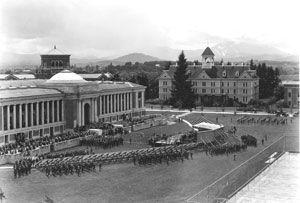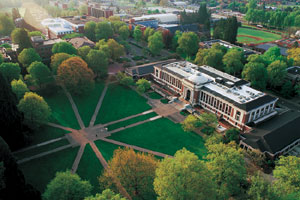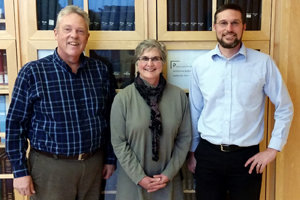
Dedication of the Memorial Union, June 1, 1929.
Harriet's Photographic Collection, Special Collections and Archives Research Center. (Click to enlarge)
About the Project
Conducted from 2013 to 2017, the Oregon State University Sesquicentennial Oral History Project is the largest oral history initiative in OSU's history. Sponsored by the OSU Office of the Provost, OSU Marketing and Relations, OSU Libraries and Press (OSULP), the OSU Foundation, the OSU Alumni Office, and The Oregon Stater alumni magazine, the project's mission was to holistically document the history, impact and ambitions of the university through the recollections of various alumni, faculty, staff, administrators, current students, and supporters affiliated with OSU. The project was one of many to be sponsored in anticipation of the university's year-long sesquicentennial celebration in 2017 and 2018.
All interviews presented on this website may be browsed through an A-Z list or explored by interviewee affiliation or theme. Interview transcripts are also presented alongside each video in downloadable PDF format.
In addition, .mp3 audio files of every session are freely available for download via this link.
Along with their presentation on this web portal, the interviews gathered for the project have been described as an archival collection. For more, see the finding aid to the Oregon State University Sesquicentennial Oral History Collection (OH 26).
Project Details
OH 150, as it was known to the project team, includes:
- More than 100 interviews with OSU alumni from every decade beginning with the 1930s.
- Over 100 additional interviews with OSU faculty, both current and emeritus.
- Another 20 interviews with OSU staff (current and retired) and 10 more with current OSU students (undergraduate and graduate).
- OSU President Ed Ray gave four interviews for the project, as did President Emeritus John Byrne. President Emeritus Paul Risser was interviewed twice less than four months before he passed away in July 2014.
- All of OSU's colleges are represented within the collection, including the Graduate School and the University Honors College. So too are OSU's branch campuses: the Hatfield Marine Science Center in Newport and OSU-Cascades in Bend. Twenty-five interview sets include OSU's Extension and Experiment Stations as a major theme. Other institutional areas of strength include the OSU Foundation, the Linus Pauling Institute, OSU Libraries and Press, and OSU Ecampus.
- OSU's Land Grant heritage and mission are documented throughout the project. Specific interviews focusing on Sea Grant, Space Grant and Sun Grant at OSU are included as well.
- The collection features interviews with two dozen OSU Distinguished Professors, four members of the OSU Board of Trustees, and the three co-chairs of the $1 billion Campaign for OSU: Pat Reser, Jim Rudd and Pat Stone.
- Some of the collection's most significant topical strengths include the Advancement of Women, Athletics, Entrepreneurship, Environmental Sustainability, International Studies, Journalism, Military Service, Multiculturalism, Oceanography and Public Service.
- Within Oregon, project staff traveled to Bend, Hood River, Klamath Falls, Newport, Pendleton and Sutherlin, as well as many locations up and down the Willamette Valley, to collect interviews. Outside of the state, interviews were conducted in Denver, Colorado; Houston, Texas; Longview, Washington; Norman, Oklahoma; Saratoga, California; and Washington, D.C.

The Memorial Union and central campus, as viewed from above, 2010.
Oregon State University. (Click to enlarge)
By the Numbers
Project Data
- Interviews: 243
- Interview Time: 350:04:18
- Words Transcribed: 2,984,570
- Volume of Digital Content Collected: 1.81 TB
Portal Data
In addition to the 243 interviews collected specifically for this project, another 33 sessions conducted between 2007 and 2012 for previous OSU oral history projects were included on the OH 150 portal. The total amount of content made available on this website is as follows:
- Interviews: 276
- Interview Time: 407:29:13
- Words Transcribed: 3,428,776
Project Team
The team responsible for creating this project and its online representation is as follows: Chris Petersen, project director and oral historian; Mike Dicianna, oral historian; Janice Dilg, oral historian; Kalia Flocker, research lead; Shannon Riley, writing assistant; Ryan Wick, web designer; Patch Leishman, graphic designer.
The project's executive committee consisted of Molly Brown (OSU Foundation), Faye Chadwell (OSULP), Steve Clark (University Marketing and Relations), Christi Kasten (OSU Alumni Association), Larry Landis (OSULP), and Kevin Miller (The Oregon Stater). Additional funding support for the project was generously provided by two programs within the Special Collections and Archives Research Center (SCARC): the Oregon Multicultural Archives, and the Oregon Hops and Brewing Archives.
Numerous other individuals contributed to the project including, as interviewers, Anne Bahde, Dominic Cusimano, Tiah Edmunson-Morton, Gregory Garcia, Adam LaMascus, Steve Matthes, Karl McCreary, Linda Richards, Trevor Sandgathe, Bob Schapper, and Geoff Somnitz. Special thanks are due as well to Raul Burriel (Academic Technologies), Elizabeth Grubb (President's Office), Penny Hardesty (OSU Foundation), and Shelly Signs (University Events), and to Hope Glenn, Angela Barker, Cody Hess, Eric Johnson, Lauren Lovestone, Michelle McKay, Anna Mitchell, John Ngo, Mary Lou Russ, and Christopher Russell, all student assistants or volunteers in SCARC.
Technical Notes
Interviews led by project staff were captured using both video and audio recorders, and the archival-quality .mts video files and .wav audio files that were created as a result of this process have been stored in multiple locations, including the OSULP preservation server. Raw .mts video files for a specific interview were also compiled in Adobe Premiere Elements and the .m2t file that resulted was uploaded for presentation on OSU's MediaSpace media distribution platform. Online versions of each interview are available in two locations: as raw video files accessible through OSU MediaSpace and, once transcribed, as contextualized websites presented on the project's dedicated web portal.
The project portal was created using a combination of METS/MODS metadata records to describe digital objects; TEI-encoded transcripts; and custom XSL stylesheets that enable the presentation of the embedded MediaSpace video player on an HTML template created by the Special Collections and Archives Research Center. A more detailed technical discussion of the infrastructure powering the OH 150 website is available here.
The project's interviews were transcribed by two professional transcription services, members of the SCARC staff, and a handful of dedicated volunteers.
About Oregon State University
Founded in 1868, OSU is the state's Land Grant university and is one of only two universities in the U.S. to have Sea Grant, Space Grant and Sun Grant designations. Oregon State is also the only university in Oregon to hold both the Carnegie Foundation's top designation for research institutions and its prestigious Community Engagement classification.
As Oregon's leading public research university, with $441 million in external funding in the 2017 fiscal year, Oregon State's impact reaches across the state and beyond. With 11 colleges, 15 Agricultural Experiment Stations, 35 county Extension offices, the Hatfield Marine Sciences Center in Newport and OSU-Cascades in Bend, Oregon State has a presence in every one of Oregon's 36 counties, with a statewide economic footprint of $2.371 billion.
Oregon State welcomes a diverse student body of over 30,000 students from across Oregon, all 50 states and more than 100 countries. They can choose from more than 200 undergraduate and more than 80 graduate degree programs, including over 30 degrees offered online through Oregon State Ecampus. Oregon State increasingly attracts high-achieving students, with nationally recognized programs in areas such as conservation biology, agricultural sciences, nuclear engineering, forestry, fisheries and wildlife management, community health, pharmacy and zoology.
The 400-acre main campus in Corvallis includes a Historic District, making Oregon State one of only a handful of U.S. university campuses listed on the National Register of Historic Places. The district includes such icons as Weatherford Hall, the Memorial Union and Benton Hall, the oldest building on campus.
Contact
This website is a product of the Oral History Program at the OSULP Special Collections and Archives Research Center. For more information, please contact us at scarc@oregonstate.edu
Release Date: October 16, 2017

